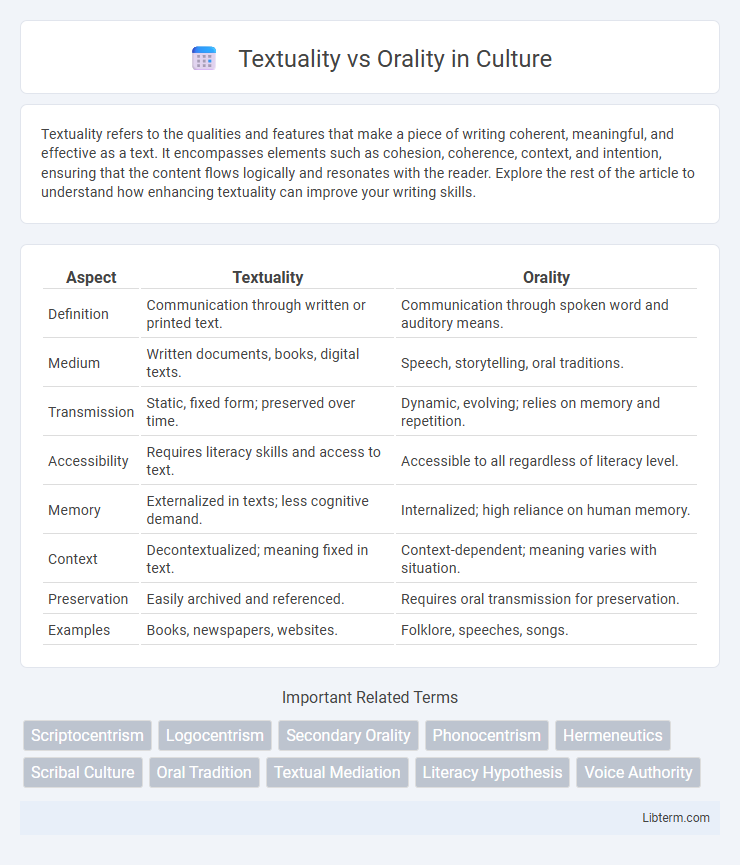Textuality refers to the qualities and features that make a piece of writing coherent, meaningful, and effective as a text. It encompasses elements such as cohesion, coherence, context, and intention, ensuring that the content flows logically and resonates with the reader. Explore the rest of the article to understand how enhancing textuality can improve your writing skills.
Table of Comparison
| Aspect | Textuality | Orality |
|---|---|---|
| Definition | Communication through written or printed text. | Communication through spoken word and auditory means. |
| Medium | Written documents, books, digital texts. | Speech, storytelling, oral traditions. |
| Transmission | Static, fixed form; preserved over time. | Dynamic, evolving; relies on memory and repetition. |
| Accessibility | Requires literacy skills and access to text. | Accessible to all regardless of literacy level. |
| Memory | Externalized in texts; less cognitive demand. | Internalized; high reliance on human memory. |
| Context | Decontextualized; meaning fixed in text. | Context-dependent; meaning varies with situation. |
| Preservation | Easily archived and referenced. | Requires oral transmission for preservation. |
| Examples | Books, newspapers, websites. | Folklore, speeches, songs. |
Defining Textuality and Orality
Textuality refers to the characteristic features and structures inherent in written texts, encompassing elements like syntax, grammar, and permanence that allow for detailed analysis and interpretation. Orality denotes the quality of spoken communication, emphasizing temporal ephemerality, interactive dynamics, and reliance on memory and vocal expression rather than physical inscription. Understanding the distinctions between textuality and orality is crucial for studying language, culture, and communication methods across different societies.
Historical Evolution of Communication
The historical evolution of communication highlights a shift from orality, dominated by spoken language and memory-based transmission in ancient societies, to textuality, characterized by written records enabling information preservation and widespread dissemination. Ancient civilizations like Mesopotamia and Egypt pioneered writing systems such as cuneiform and hieroglyphics, marking a crucial transition in human communication methods. This transformation facilitated complex bureaucracy, cultural continuity, and expanding knowledge horizons by enabling communication across time and space beyond immediate interpersonal exchanges.
Cognitive Differences in Oral and Written Cultures
Oral cultures rely heavily on memory, repetition, and mnemonic devices to transmit knowledge, shaping cognitive processes that favor auditory learning and immediate social interaction. Written cultures encourage analytical thinking, abstraction, and complex organization of information, supporting cognitive skills related to long-term memory and critical evaluation. These cognitive differences influence how individuals process, internalize, and communicate knowledge across oral and textual traditions.
Social Dynamics Shaped by Orality and Textuality
Social dynamics shaped by orality emphasize face-to-face interaction, trust-building through vocal nuances, and community cohesion fostered by shared oral traditions. In contrast, textuality enables the preservation of knowledge across time and space, facilitating complex bureaucratic systems and widespread information dissemination. These differing communication modes influence power structures, with orality supporting egalitarian dialogues and textuality often centralizing authority through institutionalized records.
Memory and Knowledge Transmission
Textuality enhances memory retention by creating permanent records that enable precise knowledge transmission across generations, contrasting with orality's reliance on human memory and communal repetition. Oral traditions depend on mnemonic devices and performative techniques to preserve information, which can lead to variations and adaptations over time. The shift from orality to textuality transforms the dynamics of knowledge preservation, facilitating broader dissemination but potentially reducing the fluidity and contextual richness of transmitted knowledge.
Literacy’s Impact on Society
Literacy fundamentally transforms society by enabling complex information storage, dissemination, and analysis through textuality, which contrasts with orality's reliance on memory and spoken communication. Textuality fosters the development of institutions, legal systems, and scientific progress by providing a stable, permanent record that transcends time and space. The shift from orality to textuality enhances cognitive skills such as abstract thinking and critical analysis, reshaping cultural structures and societal organization.
Challenges of Preserving Oral Traditions
Preserving oral traditions poses challenges due to their inherent reliance on memory and performance, which are vulnerable to distortion and loss over time. Unlike textual records, oral narratives lack fixed versions, making consistency and authenticity difficult to maintain across generations. Technological advances in audio and video recording help mitigate these risks but cannot fully replicate the interactive and contextual nuances of live oral transmission.
Technological Influences on Communication
Technological advances have radically transformed communication by shifting the dominance from orality to textuality, enabling the widespread use of written and digital forms. The invention of the printing press and the rise of the internet have facilitated the preservation, dissemination, and accessibility of textual information, creating a shift towards more permanent and retrievable records compared to ephemeral oral traditions. Digital platforms and mobile technologies further enhance this evolution by supporting instant written interactions, bridging geographical gaps, and fostering new modes of textual communication such as social media and instant messaging.
Intersections of Orality and Textuality in the Digital Age
The digital age blurs traditional boundaries between textuality and orality through multimedia platforms that combine spoken language, written text, and visual elements. Digital communication channels like social media, podcasts, and video streaming enable simultaneous oral and textual interactions, enhancing connectivity and information exchange. These intersections foster dynamic narratives that leverage the immediacy of orality with the permanence and accessibility of text, reshaping cultural expression and knowledge dissemination.
The Future of Human Expression: Blending Text and Voice
The future of human expression lies in seamlessly blending textuality and orality, harnessing the strengths of both written and spoken communication for richer interaction. Advancements in natural language processing and AI voice synthesis enable dynamic dialogue that combines the precision of text with the emotional nuance of voice. This convergence fosters more accessible, immersive, and context-aware communication across digital platforms, transforming how humans connect and share ideas.
Textuality Infographic

 libterm.com
libterm.com